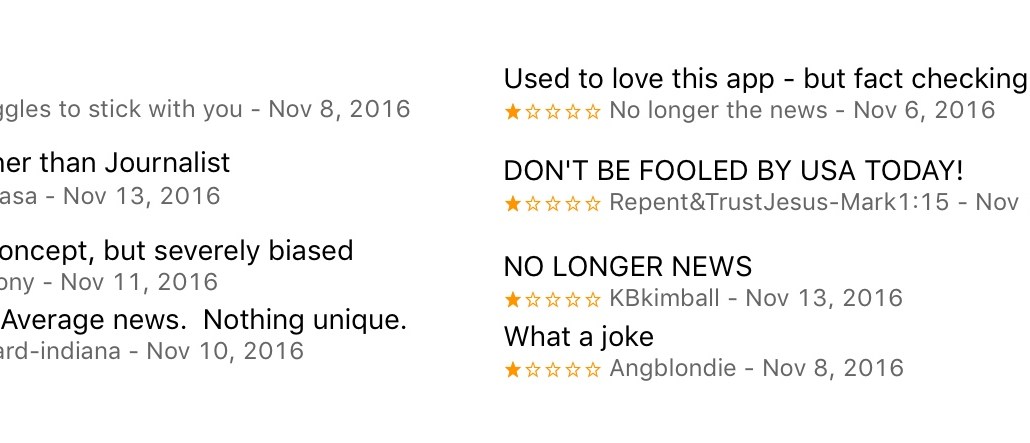
Two new fronts have opened up in the battle between the left and the right over media bias: the Apple App Store and Google Play.
In the past couple weeks, a number of prominent news publishers, including CNN, Mic, Quartz and USA Today have been hit with a flurry of one-star reviews from people claiming that the apps have a liberal bias. More than half of all the reviews CNN’s app received this month in Apple’s App Store were one-star reviews accusing it of having a liberal bias; more than two-thirds of the one-star reviews USA Today’s iPhone app received over the same period claimed the publication had a liberal bias. In the app store, a full third of the reviews Mic has received since it debuted its app 10 days ago have done the same, and 40 percent of the 25 reviews Quartz’s app has ever received mention the bias of its content.
In Google Play, the percentage of one-star reviews that claim bias is lower, mostly because the variety of devices that run the Android operating system leads to more bugs. But the numbers there are substantial too. Both CNN and USA Today received hundreds each.
“Absurdly left-leaning rhetoric,” one user wrote about Quartz’s app on Nov. 4. “I’m all for the first amendment but also representing the facts.”
“Literally nothing but LIARS!” another wrote about CNN’s.
For the more established apps, which have amassed thousands of user reviews, one month’s worth of angry comments isn’t likely to have far-reaching consequences. A USA Today spokesperson said that its app’s daily average traffic has been normal since Nov. 10, after huge spikes on Nov. 8 and 9.
But in the case of newer apps, these batches of negative reviews have the ability to jeopardize their positions in app stores and their prospects for growing an audience.
“It becomes this cycle,” said Amir Ghodrati, the director of market insights at app analytics firm App Annie. “Lower reviews affect the ranking of an app in the top charts, which decreases app discoverability and, in turn, means fewer downloads, which would continue driving them further down the top charts.”
Ghodrati, who noted that apps should try to maintain at least a four-star rating, added that strong brand loyalty does mitigate some of these effects. Currently, Mic’s new app has an average rating of 2.5 stars in the App Store, Quartz’s average is three stars, and both publishers said they’re happy with audience growth there.
None of the publishers contacted for this story saw the surge of negative comments as something to worry about. “It doesn’t concern us,” said Zach Seward, Quartz’s vp of product. “It’s pretty common for news apps to be rated based on perceived bias.”
Seward, who noted that Quartz has never endorsed any political candidates, added that the week following the election, his company’s app had the biggest audience it had gotten since the week it launched. A company rep declined to share further details about the size of that audience.
In Mic’s case, the backlash prompted its product team to re-examine the updates they were pushing to their app audience. Its chief strategy officer, Cory Haik, and its editorial director, Kerry Lauerman, didn’t find anything they thought warranted correction, though Haik noted that since those reviews began coming in, Mic has been “extra vigilant” about looking at whether this new audience is getting a good balance of information.
“We definitely considered the feedback,” Haik said.
Mic’s mobile app has been live for less than two weeks. It’s attracted an audience Haik described as tens of thousands, and she expects it to grow quite a bit larger, as Mic’s stories address issues that are important to people on both sides of an ever-widening ideological divide. That will be key for Mic and others moving forward, not just on their mobile apps, but everywhere. “It’s a broader media issue,” she said.
More in Media

Digiday+ Research: Publishers’ growing focus on video doesn’t translate to social platforms
Major publishers have made recent investments in vertical video, but that shift is not carrying over to social media platforms.

Technology x humanity: A conversation with Dayforce’s Amy Capellanti-Wolf
Capellanti-Wolf shared insight on everything from navigating AI adoption and combating burnout to rethinking talent strategies.

How The Arena Group is rewriting its commercial playbook for the zero-click era
The company is testing AI-powered content recommendation models to keep readers moving through its network of sites and, in doing so, bump up revenue per session – its core performance metric.





